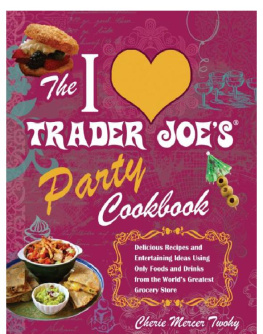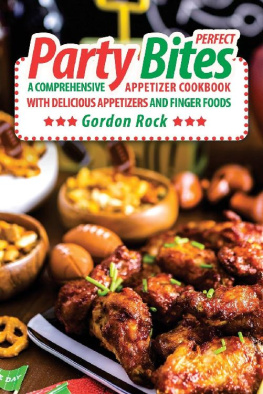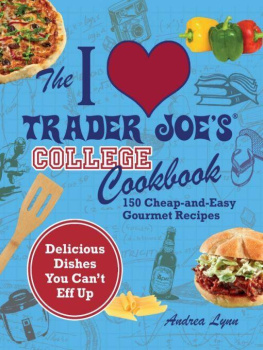ACKNOWLEDGMENTS
I spent a lot of time on the thank-you list for my first book, as it never occurred to me that Id write more than one! Id really like to just thank all those same folks again, but I guess thats not the way to do this.
Im still shaking my head over how Ulysses Press reached out to meI became a first-time author over the Internet! Its a crazy story, and one that I often tell at speaking engagements as an illustration that anything can happen in life. I have to pinch myself to believe that Im finishing my second book, and I have Keith Riegert and Lauren Harrison to thank for making the process (relatively) painless. Their support and enthusiasm for both books have been a great source of encouragement.
I have met so many amazing Joes over the years, and they have been upbeat and positive about their jobs. How many corporations can you say that about these days? I thank everybody in the organization for all the great stuff they find, sell, and support, and for the fun stores to shop in. Keep on growin, folks!
I honestly cannot thank the students of Chez Cherie enough. They have stuck by us through thick and thin, in times of economic boom and bust! Im overwhelmingly grateful for the friendship, positivity, and cheerleading weve enjoyed from our fabulous students.
My staff at Chez Cherie has not changed much over the years, and for that I am so very grateful. Im blessed with a rock-star team of amazing women, and without them, my cooking life would be flat and flavorless. Chris Delgado, GeGe Engwald-Parry, Whitnee Haston, Valerie Barth, and Kareen Rowe have been by my side in classes and in life for years, and Im so thankful to each of them. Chris and Whit worked on the prep and styling for the photo shoots on this book, which was such a huge help! Our girl power has extended to the scullery for the past few years, and our dishwashers, most often Gretchen and Anna, have kept our dishes sparklingeven the dreaded souffl ramekinswith good humor. Thanks, ladies!
What would we do without friends? Im blessed with too many to name (and terrified of omitting someone). Hugs and gratitude to all, for your support, encouragement, advice, and love. Right back atchya.
And finally, my family. Im not a gambler, because I used up all my good luck in the kid lottery. Steve and I are the luckiest parents on the planet, and Matt (who helped prep and style the photos for the book), Kevin (who took the awesome food shots), and Brenna (whos gonna write her own book someday) are the best, smartest, funniest, and most all-around fabulous humans I could have hoped to have in my life. Having that trio around is always my greatest joy. Love ya, kiddos.
APPENDIX
TECHNIQUES
Since you cant all come to Chez Cherie to learn all the secrets I pass along in my Trader Joes classes, heres a short course on techniques mentioned in this book, from A to Z. Some of you may already be familiar with these techniques, but you never know, you might pick up some culinary-school lore to add a little pizzazz to your cooking!
AL DENTEThe key to perfect pasta, this term means to the tooth, and describes that tiny bit of resistance that remains in the noodle after its properly cooked. Because pasta continues to cook a little bit as you drain it and before its sauced, when you bite into a piece to check doneness, there should be a tiny bit of tooth resistance. But no crunch! Practice makes perfect here, and pasta practice is never a bad thing!
BLIND BAKINGThis method of preparing pie crust helps ensure a crisp bottom crust and is also done for pies with unbaked fillings, like a fruit tart filled with pastry cream. Heres how to do it: Preheat the oven to 375F. Roll out the pie dough and fit it into an 8- or 9-inch pie pan or removable-bottom tart pan. Cover the pastry with a sheet of parchment that youve crumpled and then straightened out. (The wrinkles help the parchment form to the contours of the baking pan.) You can use aluminum foil instead of parchment, but dont use waxed paper. Cover the surface with pie weights, raw rice, or dried beans. (Youll need about 2 cups of raw dried beans or rice; you can reuse them a few times before they start to smell a bit baked.) Place the pan in the oven for 12 minutes. Carefully lift out the parchment, with the weights inside, and return the pan to the oven for 5 to 10 minutes, until the pastry is dry and golden. If youll be adding a filling that goes back in the oven, underbake the pastry a bit; if the filling wont be baked, bake the pastry until it is completely done and beautifully browned.
CHIFFONADEJust a chef-y word for thin ribbons, usually of herbs. To make them, stack up a few leaves (of basil, for example) and then roll them, as you would a stack of paper, into a scroll. Starting at one end of the roll, glide your knife through the rolled-up leaves, slicing them into thin ribbons. When you reach the end of the roll, fluff the pile of sliced leaves to separate them. Voila! Pretty and fragrant basil chiffonade, perfect for garnishing many dishes that would benefit from a scattering of tasty green ribbons.
DEGLAZEThis process incorporates all the lovely bits of food that have developed on the bottom of a saut pan into the sauce. Its usually accomplished by adding a slightly acidic liquid (wine, anyone?) to the pan and stirring gently with a spatula until the bottom of the pan is clean and the flavorful stuff that was lurking there has been loosened. If you prefer to use broth for this rather than wine, a drop or two of lemon juice or vinegar will help the process along. You shouldnt need to scrape the pan with the spatula. Just stir gently after the liquid comes to a simmer and all should be well.
DEVEINIf your shrimp dont already come deveined, its a simple process. If the shrimp are already peeled, just stick the tip of a knife under the thin, dark line that extends down the back of the shrimp. Lift the membrane out and discard. If the shrimp have the shell intact, use a thin-bladed knife or kitchen shears to split the shell along the top edge (not where the little fringe-like legs are located). Peel the shell off, and then use the technique above to pull the vein out. That little black vein is harmless but it can contain sandy bits that wont complement your saffron crme sauce!
JULIENNEThis technique produces those thin strips or sticks you see in the restaurants without a lot of work. By cutting thick strips of vegetables or meat and then stacking a few of those strips and gliding your chefs knife through them again (the long way), youll get thinner strips. Need even thinner ones? Just stack and glide again. (Kinda the lather, rinse, repeat of the kitchen!) Until your knife skills are rocking, dont make the stacks too high. Better to be safe than get stitches.
SAUTTechnically, this means to make the foodjumpin the pan, with that impressive arc, like TV chefs do. In our Chez Cherie Basic Cooking series, we encourage students to practice this with a snack-size resealable plastic bag half-full of M&Ms. Once theyve mastered the flip (in a room-temperature pan, of coursea hot pan would make this whole thing impossible!), they get to try it with loose candies. Muuuch harder, but I tell them they can eat the ones that jump out! If you want to skip this exercise, you can just use tongs or a spatula to get the food moving in the pan. The main idea is for the food to cook on all sides, so whether flipping, nudging, or turning it over with a spatula, the end result will be the same. I usually prefer a regular pan, not a non-stick pan, for sauting because the untreated surface seems to heat faster and more evenly, allowing that lovely film of flavor to develop on the bottom of the pan (see






